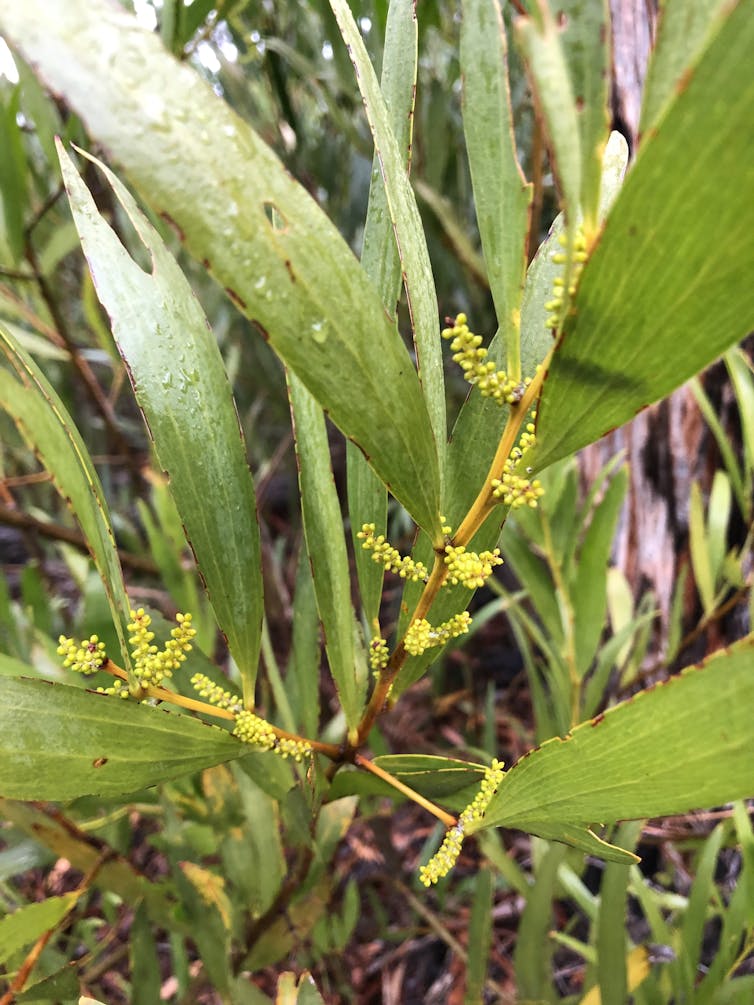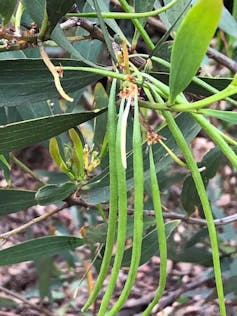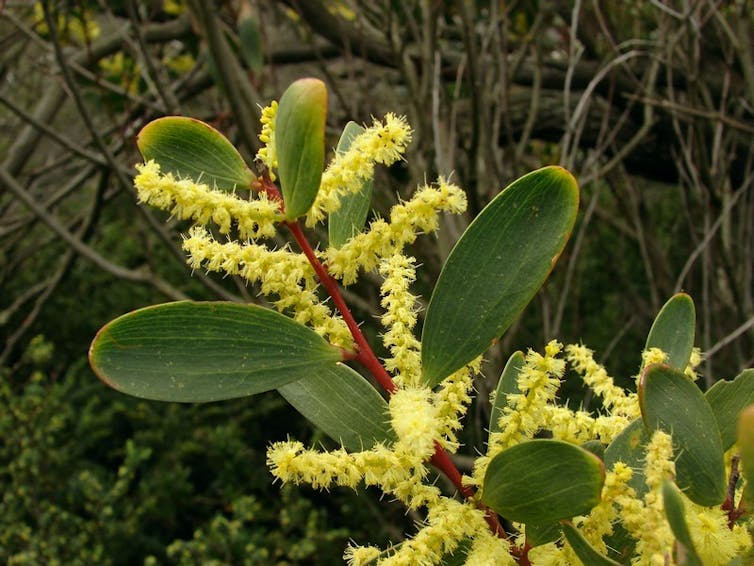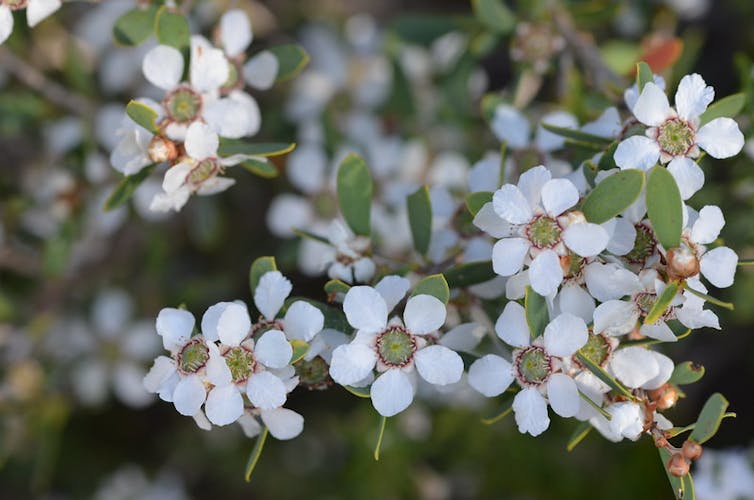Planning to plant an Australian native like wattle? Read this first — you might be spreading a weed
Australian native plants are having a moment in the sun, with much of United States seeking out and planting native species than in the past. Our gardens — and our social media feeds — are brimming with beautiful Australian native blooms.
Merely not all Australian native species lie in completely Aboriginal Australian environments. In fact, many have become pests in places far from their underivative homes.
They can push out other native endemic species, bear on the local balance of insects and other animals, bust up soils and even gain fire risk.
Here are three Continent native plants that have get encroaching species after ending up in places they don't belong.
Sydney golden wattle (Acacia longifolia subspecies longifolia)
Originally extending from East Gippsland in Victoria up about atomic number 3 far as Brisbane in Queensland, this species is without doubt attractive. It's besides an invasive skunk in parts of Victoria, South Australia and Western Commonwealth of Australi.
It was spread across the res publica away well-intentioned gardeners who adage information technology as a charming nonfunctional plant. Nevertheless, its seeds ready-made their way into the wild and took off — IT's what's known in my field American Samoa "a garden escapee".
Like many widow's weeds, this species can capitalise on a instinctive disaster; after fire it posterior send out shoots from its base. Acacias are often uncomparable of the first species to sprout following a bushfire. They're now completely dominant and spreading in many areas.

Lamella Neil Armstrong, Source provided
Seeds of Sydney Acacia pycnantha can go in the soil for many decades, long after the parent plants have died. The heat from a fire cracks the hard seminal fluid coat, allowing body of water to enter and germination to take off.
In the Grampians, in Victoria, Sydney golden wattle is causing terrible begrime problems. Many native plants endemic to this area don't like high levels of soil nitrogen, just Acacia longifolia subsp. longifolia is a nitrogen-fastener plant.

Lamella Armstrong, Author provided
In other run-in, it increases the atomic number 7 in the soil and changes the soil nutrient status and even physical aspects of the soil. It can grow tall and produce a dish out of foliage, which reduces the amount of Christ Within forthcoming to the ground. That makes it harder for native species lower to the earth to survive.
This is a major challenge, particularly in biodiversity-rich places like the Grampians.
Seashore lappet (Acacia longifolia subspecies sophorae)
The blooms along Acacia longifolia subspecies sophorae (Coast lappet) look about the same as many other wattles, but the leaves are a bit shorter and stubbier.
Originally, Coast wattle occurred along the east seacoast from west Victoria — up about every bit far As Brisbane and down south as far as Tasmania (where Sydney Acacia pycnantha did not occur course).

Tatters ✾/Flickr, CC BY
It was primitively circumscribed to sandy sites at the upside of beaches but has been deliberately planted as a "sand-binder" in other sites. It's also naturally spread into heathlands inland of the beaches and is now causing vast problems around our coasts.
Like the earlier example, it dominates local ecosystems and displaces native species endemic to the area (in particular in our species-rich heathlands), which affects local insect habitats. It is also now modifying natural sandpaper dune patterns.
IT is increasing attack risk by changing heathland plant profiles from mostly short shrubs of constricted bulk to tall, stupid shrublands with much high fuel levels.
Sea-coast teatree (Leptospermum laevigatum)
As with Coast lappet, Coast teatree was formerly qualified to a narrow strip on sandy soils merely above the beaches of southland-oriental Australia. But IT has now spread into near heathlands and woodlands. IT's even reached as far as Western Australia.

Flickr/Margaret Donald, CC Away
This teatree plant is now considered an invasive species in parts of Victoria Falls and Southward Australia.
Although the mature plants are usually killed by fire, the seeds are abundant and real good at surviving; they pop out of their capsules later on fires.

Dr David Chael, Generator provided
They are high-density plants that burn quickly in a fire. They are very quick to take over and obtrude autochthonous species.
For example, parts of the Wilson's Prom National Park in Victoria, which was originally a Banksia woodland, have now been converted almost to a teatree monoculture. It is identical melancholic.
A call to action
Authorities are disagreeable their best to hold bac these and other native invasive species subordinate control, but in some cases things may never go back to the way they were. Sometimes, the top-grade you can hope for is just to strike a equilibrise between aboriginal and invasive species.
When you set landcare restoration work or home gardening, I urge you to look up the found history and see if the species you're thinking of planting is listed as one that might movement problems in future.
When you go to buy up from a nursery or plant centre, atomic number 4 fabian. Think twice before you bring something into your garden. Overly umteen species have "jumped the garden fence" and now cost us a great mete out in ascertain efforts and in endemic species loss.
Stacks of apps, so much as PlantNet, can help you identify plants and imag what is autochthonous to your area.
Australia has spent billions hard to control invasive species and environmental weeds. Anything you can do to help is a fillip.
![]()
Singarayer Florentine, Prof (Restoration Ecologist), Federation University Australia
This article is republished from The Conversation low a Creative Commons license. Read the archetype article.
Source: https://hellocare.com.au/planning-to-plant-an-australian-native-like-wattle-read-this-first-you-might-be-spreading-a-weed/
0 Response to "Planning to plant an Australian native like wattle? Read this first — you might be spreading a weed"
Post a Comment